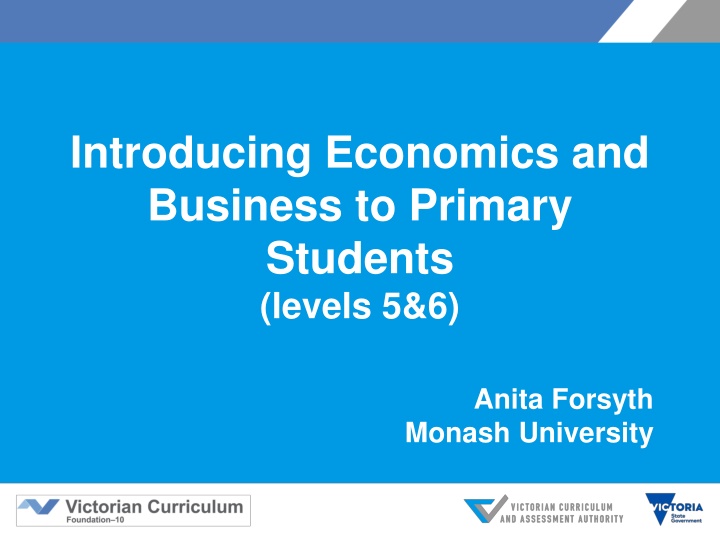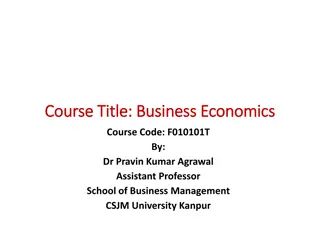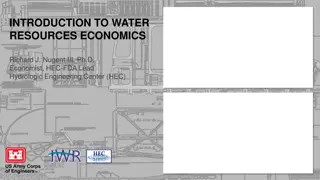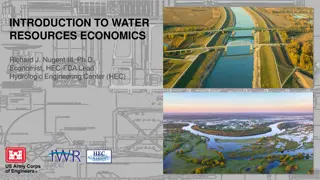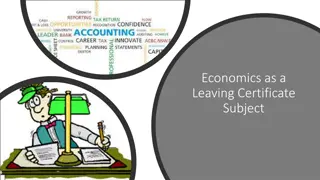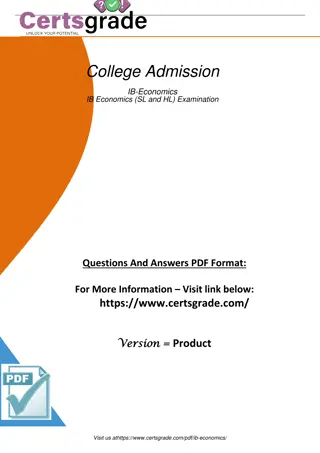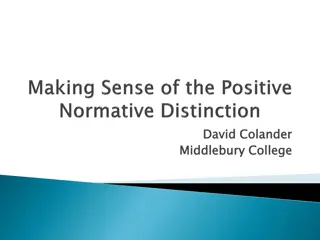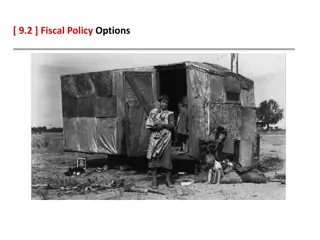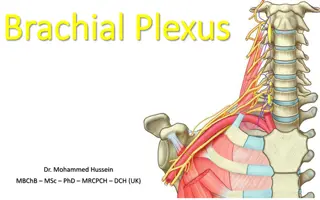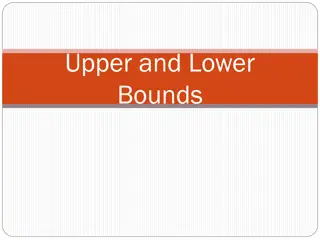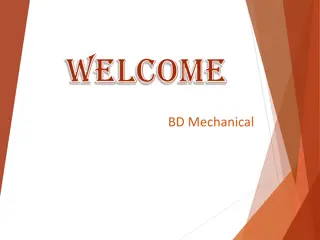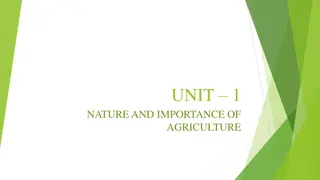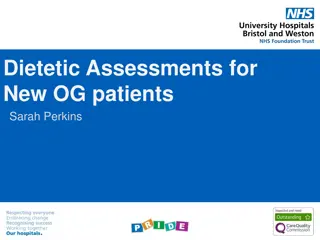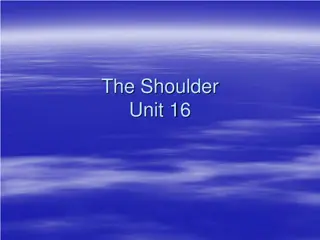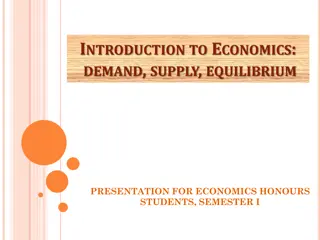Introduction to Economics & Business for Upper Primary Students
This webinar by Anita Forsyth from Monash University introduces economics concepts to upper primary students (levels 5 & 6). Key topics covered include resources, needs, wants, production, goods, services, incentives, scarcity, opportunity cost, economic decision-making, and ethical awareness. The session offers activities to engage students, such as discussing choices, distinguishing between needs and wants, and understanding scarcity through decision making. The aim is to provide a foundation for teaching economics in Years 5 & 6 while integrating key concepts with the curriculum.
Download Presentation

Please find below an Image/Link to download the presentation.
The content on the website is provided AS IS for your information and personal use only. It may not be sold, licensed, or shared on other websites without obtaining consent from the author.If you encounter any issues during the download, it is possible that the publisher has removed the file from their server.
You are allowed to download the files provided on this website for personal or commercial use, subject to the condition that they are used lawfully. All files are the property of their respective owners.
The content on the website is provided AS IS for your information and personal use only. It may not be sold, licensed, or shared on other websites without obtaining consent from the author.
E N D
Presentation Transcript
Introducing Economics and Business to Primary Students (levels 5&6) Anita Forsyth Monash University
Intentions This webinar today is talking about teaching and learning key concepts to introduce Economics to upper Primary students. Introducing economic concepts including resources, needs, wants, production, goods, services, incentives, the basic economic problem of scarcity, opportunity cost, economic decision making and ethical awareness.
Intentions (contd) Introduce some key concepts and activities to frame the learning of this content as outlined in the E&B level 5&6 standard. Recommend an approach to introduce Economics in Years 5&6 and align possible teaching and learning activities. Make links across the curriculum to show how the teaching of Economics reinforces other curriculum literacy, numeracy, ethical capability. Provide examples of resources.
Introducing some key economics concepts unit warm-up 1. People make choices because they can t have everything they want. Activity: Identify some choices you have made about what to do with your time or what to buy and explain why you had to make a choice).
Introducing some key economics concepts unit warm-up (cont d) 2. Needs are required for our survival such as food, clothing, shelter and wants are desires that can be satisfied by consuming a good (an overcoat), a service (going to the Gold Coast Commonwealth games) or leisure activity (Disneyland holiday) Activity: Make a list of 10 goods and services you have consumed in the last week and classify whether you think they were needs or wants.
Introducing some key economics concepts unit warm-up (cont d) 3. Scarcity exists because we cannot have all the goods and services we want. Human wants for goods and services exceed the quantity of goods and services that can be produced using all available resources. Activity: You have been given $30 from your parents for your birthday. List 4 different goods or services that you might like to buy with this money. Once you have made a list, explain why a choice must be made. List the items in terms of your preferences and decide how you will spend the money. Identify the opportunity cost of your decision.
Introducing some key economics concepts unit warm-up (cont d) 4. Making good choices should involve trading-off the expected value, use and enjoyment of one choice against the expected value, use and enjoyment of the next best alternative. Activity: Your family has decided to buy a pet. Determine criteria for selecting a pet for your household and identify the trade-offs made when selecting one pet over another.
Introducing some key economics concepts unit warm-up (cont d) 5. Resources are used to produce (make) the goods and services that we need and want. Resources include land (the land space and what we can mine or grow from the land), labour (mental and physical), capital (machinery and tools used to make other goods and services) and entrepreneurship (the ability of people to organize, manage, innovate and create ideas/enterprising skills to make goods and services) Activity: In order to produce the service of education at your school, develop a poster of photos and drawings of examples of the land, labour, capital and entrepreneurship resources used in the production of this education service.
Introducing some key economics concepts unit warm-up (cont d) 6. People s choices about what goods & services to buy and consume determine how resources will be used. Activity: Explain why a choice must be made, when a land owner has alternative uses for the property.
Introducing some key economics concepts unit warm-up (cont d) 7. When ever a choice is made, something is given up because resources are limited. Activity: From a list of four pieces of fruit, ask students to rank order their preferences, state their first choice and then identify the second choice as what is given up.
Introducing some key economics concepts unit warm-up (cont d) 8. The opportunity cost of an activity is the value of the best alternative that would have been chosen instead. Activity: From a list of four pieces of fruit, ask students to rank order their preferences, state their first choice and then identify the second choice as what is given up. It includes what would have been done with the money, the time, and the other resources used in undertaking the activity. So in the example of the fruit, what was the next best alternative given up? Describe another situation that requires a choice, make a decision and identify the opportunity cost.
Introducing some key economics concepts unit warm-up (cont d) 9. Most people consume and produce. As consumers they consume goods and services to satisfy their wants; as producers they help make goods and services. Activity: Provide examples of when students were consumers and provide examples of situations where students helped to produce goods and services.
Introducing some key economics concepts unit warm-up (cont d) 10 . People usually respond predictably to positive and negative incentives. Rewards are positive incentive that make people better off; penalties are negative incentives that make people worse off. Both positive and negative incentives affect people s choices and behavior. Peoples views of rewards and penalties differ because people have different values. Therefore an incentive can influence different people in different ways. Activity: List examples of rewards and penalties that encourage and discourage behaviours at school. Identify the monetary and non- monetary incentives of completing chores at home, buying environmentally friendly detergents and buying clothes with a Fairwear sticker.
An inquiry approach to apply this knowledge Integrating children s literature to teaching these economic concepts The book selected is The Little Red Hen. This is a classic children s story of the little red hen who lives in the farmyard and finds some seeds, deciding to plant them, harvest them and make bread. Key concepts covered in the story include resources land, labour, capital and entrepreneurship; incentives; choices; production.
Teaching and learning activities Read the story out loud with the class. If you cannot access a copy of the book, you could read the story from an on- line version such as YouTube. https://www.youtube.com/watch?v=smspKuKqt5c or http://www.econedlink.org/interactives/EconEdLink-interactive-tool- player.php?filename=Little_Red_Hen.swf&lid=389
Ask students to either tell you what they think the story is about, or write down a few ideas. Using the stem, It s about record the ideas on the board. Discuss the ideas recorded, grouping common ideas and themes. Invite students to ask questions about the story. Record these on the board and discuss.
The story is about: Producing a loaf of bread Production is carried out in a sequence or steps. What steps were involved with the production of the loaf of bread? Students could be asked to arrange the big ideas of the story in story order [For example - Story Order; Found the wheat seeds, Planted the seeds, Watered the garden, Pulled the weeds, Harvested the wheat, Went to the miller, Ground the wheat, Read the recipe, Mixed the ingredients, Baked the Bread, Ate the Bread] Resources needed to produce the loaf of bread. List the resources needed to produce the loaf of bread. How to make a loaf of bread, from a recipe.
How to make a loaf of bread? From a recipe to make a loaf of bread, identify the resources that are required to bake the bread. Group them under the headings of land, labour, capital and entrepreneurship. Students could go through the process of baking bread and describe the resources needed, the recipe procedures (the production process), measuring ingredients (links to numeracy). Ask students how the other farmyard animals might have been encouraged to be involved, that is what incentives could have been used?
The Little Red Hen gives students an opportunity to reflect on how they might feel if they did the work on a project or activity and others expected to benefit. Discuss their impressions. How might this link to ethical awareness? (Ethical decisions generate and sustain trust; demonstrate respect, responsibility, fairness and caring; and are consistent with good citizenship. These behaviors provide a foundation for making better decisions by setting the ground rules for our behavior).
Using pictures or words, have students create cards of the ingredients, tools and individuals involved in making bread. (about 15-30 in total). Then, have students sort these into productive resources - human, natural, capital or entrepreneurial. Have each student write down their answers for review by the teacher or another student. You also might create matching sets of cards and have the students use them to play concentration. For example, you have a picture of a mixing bowl and the word capital in order to create a match.
Other resources and approaches ASIC Its raining cats and dogs and chickens https://www.moneysmart.gov.au/media/559088/mst_primary_maths6.pdf In this unit students will investigate the financial and non-financial costs of becoming a pet owner. They will consider other factors such as ethical considerations and the external factors that influence the choice of pet.
Other resources and approaches ASIC Never too young to be MoneySmart with clothes Year 5 unit of work at https://www.moneysmart.gov.au/media/559071/mst_primary _integrated5.pdf
Other resources and approaches ASIC for year 6 Innovation and enterprising behaviour case study at: https://www.moneysmart.gov.au/media/559065/mst_pri mary_innovationandenterprise_casestudy.pdf
Megan Jeffery Curriculum Manager Economics and Business Ph: (03) 9032 1696 jeffery.megan.j@edumail.vic.gov.au
